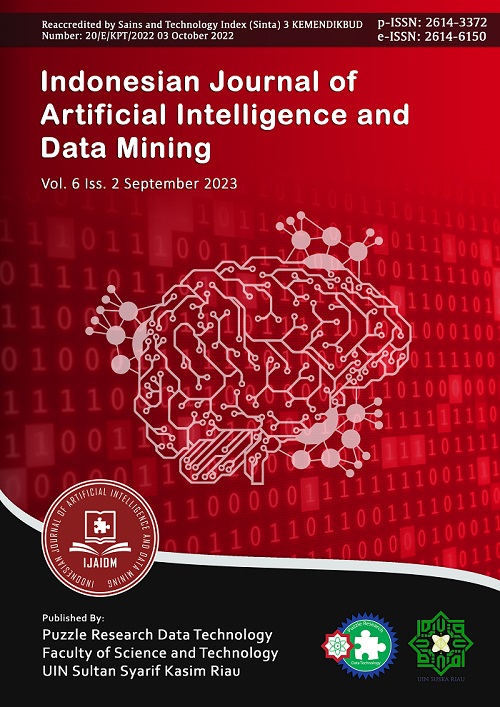Prediction Model of Revenue Restaurants Business Using Random Forest
DOI:
https://doi.org/10.24014/ijaidm.v%25vi%25i.24984Keywords:
Machine Learning, Prediction, Random Forest, RevenueAbstract
This research was conducted to predict the level of revenue from the Soto Kwali Pak Wasis restaurant business using Machine Learning. The Random Forest method was chosen because it can predict optimal and fast results with low hardware requirements. Prediction Model results using the Random Forest method resulted in an average accuracy value of 75.4% from a combination of 4 experiments. Thus, the Random Forest method is one of the flexible algorithms and is very suitable for predicting revenue in the Soto Kwali Pak Wasis restaurant business because of its good speed, high accuracy, and requires lower costs.References
B. Farnham, S. Tokyo, B. Boston, F. Sebastopol, and T. Beijing, “Hands-on Machine Learning with Scikit-Learn, Keras, and TensorFlow Concepts, Tools, and Techniques to Build Intelligent Systems SECOND EDITION,” Sebastopol, CA: O’Reilly Media, 2019, pp. 199–200.
I. Kumar, J. Rawat, N. Mohd, and S. Husain, “Opportunities of Artificial Intelligence and Machine Learning in the Food Industry,” J Food Qual, vol. 2021, 2021, doi: 10.1155/2021/4535567.
K. Hakala et al., "Neural Network and Random Forest Models in Protein Function Prediction," in IEEE/ACM Transactions on Computational Biology and Bioinformatics, vol. 19, no. 3, pp. 1772-1781, 1 May-June 2022, doi: 10.1109/TCBB.2020.3044230.
K. Saetia and J. Yokrattanasak, “Stock Movement Prediction Using Machine Learning Based on Technical Indicators and Google Trend Searches in Thailand,” International Journal of Financial Studies, vol. 11, no. 1, Mar. 2023, doi: 10.3390/ijfs11010005.
K. Singh, P. M. Booma, and U. Eaganathan, “E-Commerce System for Sale Prediction Using Machine Learning Technique,” in Journal of Physics: Conference Series, IOP Publishing Ltd, Dec. 2020. doi: 10.1088/1742-6596/1712/1/012042.
K. ŞAHİNBAŞ, “Price Prediction Model for Restaurants In Istanbul By Using Machine Learning Algorithms,” Ekonomi İşletme ve Maliye Araştırmaları Dergisi, vol. 4, no. 2, pp. 159–171, Aug. 2022, doi: 10.38009/ekimad.1148216.
K. Zahoor, N. Z. Bawany, and S. Hamid, “Sentiment analysis and classification of restaurant reviews using machine learning,” in Proceedings - 2020 21st International Arab Conference on Information Technology, ACIT 2020, Institute of Electrical and Electronics Engineers Inc., Nov. 2020. doi: 10.1109/ACIT50332.2020.9300098.
M. Shoira, F. S. Usmanov, and B. S. Ubaydullayev, “Problems in the Implementation of Quality Management Systems in Small Business Enterprises,” , Erb, vol. 7, pp. 54–57, Apr. 2022.
Mr. T. Phase, “Predict the Level of Income using Random Forest Classifier,” Int J Res Appl Sci Eng Technol, vol. 7, no. 12, pp. 558–561, Dec. 2019, doi: 10.22214/ijraset.2019.12090.
P. Bajaj, R. Ray, S. Shedge, S. Vidhate, and D. Nikhilkumar, “SALES PREDICTION USING MACHINE LEARNING ALGORITHMS,” International Research Journal of Engineering and Technology (IRJET), vol. 07, no. 06, 2020.
R. Ghorbani and R. Ghousi, “Comparing Different Resampling Methods in Predicting Students’ Performance Using Machine Learning Techniques,” IEEE Access, vol. 8, pp. 67899–67911, 2020, doi: 10.1109/ACCESS.2020.2986809.
S. D. A. Bujang et al., “Multiclass Prediction Model for Student Grade Prediction Using Machine Learning,” IEEE Access, vol. 9, pp. 95608–95621, 2021, doi: 10.1109/ACCESS.2021.3093563.
S. Siddamsetty, R. Reddy Vangala, L. Reddy, and R. Vattipally, “Restaurant Revenue Prediction using Machine Learning,” International Research Journal of Engineering and Technology, pp.2395-0056, 2021.
T. Emmanuel, T. Maupong, D. Mpoeleng, T. Semong, B. Mphago, and O. Tabona, “A survey on missing data in machine learning,” J Big Data, vol. 8, no. 1, Dec. 2021, doi: 10.1186/s40537-021-00516-9.
U. M. Sirisha, M. C. Belavagi, and G. Attigeri, “Profit Prediction Using ARIMA, SARIMA and LSTM Models in Time Series Forecasting: A Comparison,” IEEE Access, vol. 10, pp. 124715–124727, 2022, doi: 10.1109/ACCESS.2022.3224938.
Umam, A. K., R. T. Ratnasari, and S. Herianingrum. “THE EFFECT OF MACROECONOMIC VARIABLES IN PREDICTING INDONESIAN SHARIA STOCK INDEX”. Journal of Islamic Economics and Business, vol. 5, no. 2, Dec. 2019, pp. 223-40, doi:10.20473/jebis.v5i2.15031.
V. K. Gupta, A. Gupta, D. Kumar, and A. Sardana, “Prediction of COVID-19 confirmed, death, and cured cases in India using random forest model,” Big Data Mining and Analytics, vol. 4, no. 2, pp. 116–123, Jun. 2021, doi: 10.26599/BDMA.2020.9020016.
Y. Lin et al., “Revenue prediction for integrated renewable energy and energy storage system using machine learning techniques,” J Energy Storage, vol. 50, Jun. 2022, doi: 10.1016/j.est.2022.104123.
Y. R. Chen, J. S. Leu, S. A. Huang, J. T. Wang, and J. I. Takada, “Predicting Default Risk on Peer-to-Peer Lending Imbalanced Datasets,” IEEE Access, vol. 9, pp. 73103–73109, 2021, doi: 10.1109/ACCESS.2021.3079701.
Z. Jiang, “Prediction and Management of Regional Economic Scale Based on Machine Learning Model,” Wirel Commun Mob Comput, vol. 2022, 2022, doi: 10.1155/2022/2083099.

